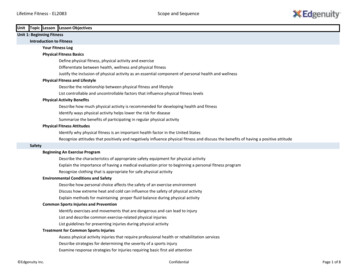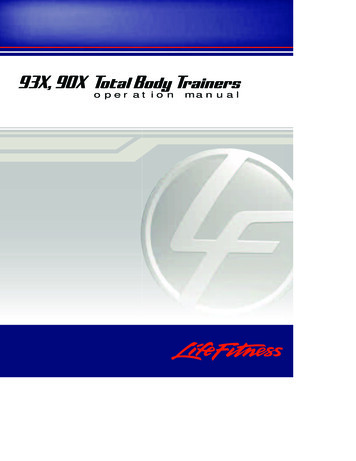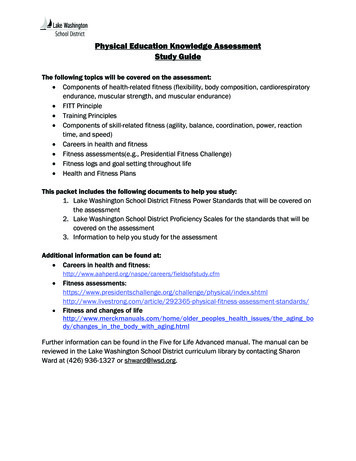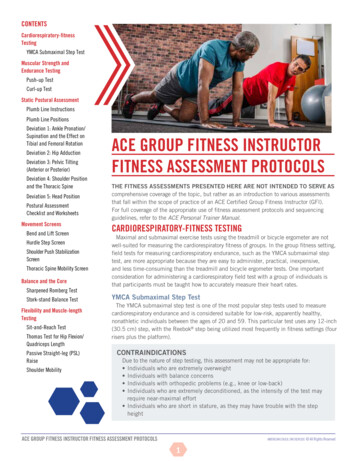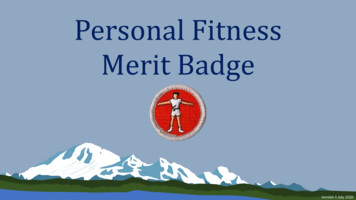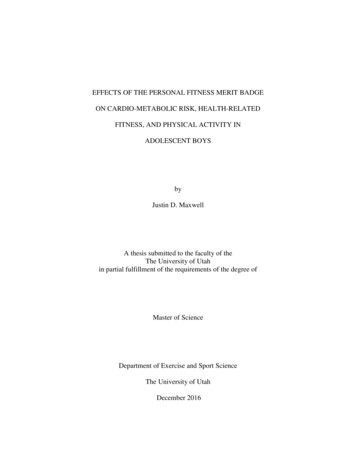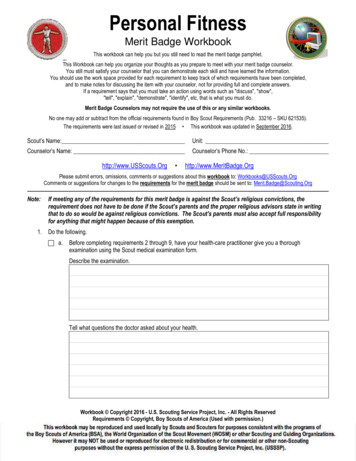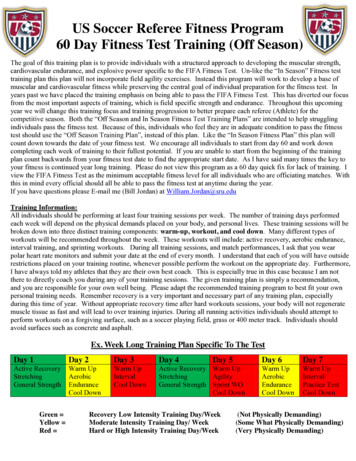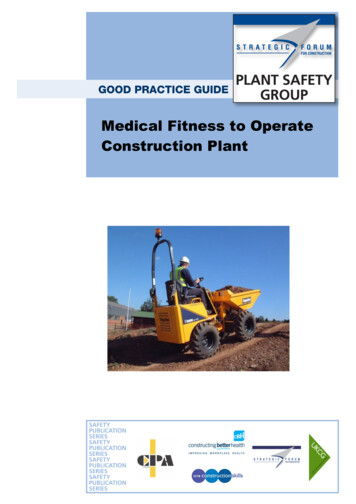
Transcription
Medical Fitness to OperateConstruction Plant
Medical Fitness to OperateConstruction PlantStrategic Forum for ConstructionGood Practice GuideReference No. CPA 1301First Published: February 2013Published by:Construction Plant-hire Association27/28 Newbury StLondonEC1A 7HUTelephone: 020 7796 3366Email: enquiries@cpa.uk.netCPA Copyright – February 2013Medical Fitness to Operate Plant2February 2013
ContentsPageForeword . .4Executive Summary .51.Introduction and Scope .62.Definitions . .73.Legislative Requirements . .104.Data Protection .115.Organisation of Medical Fitness Assessments.126.Identifying the Job Characteristics and Assessment Requirements .137.Choosing an Occupational Health Service Provider.158.Assessment Process - Initial and Ongoing .209.Medical Fitness and Recruitment .2310.Evidence of Medical Fitness for Customers . .2611.Assessment Requirements and Standards .2712.Consultation with Employees .2913.Employment Issues .30Annex AExample Self Declaration for New Plant Operators .31Annex BExample Occupational Health Questionnaire .32Annex CEmployer's Duties for the Collection and Use of Employees HealthInformation .36Annex DMinimum Competency Standards for Occupational Health ServiceProviders to the Construction Industry .38Annex EExample of a Fitness to Work Certificate .41Annex FExample of Plant Descriptions .42Annex GSeven Core Elements to be Assessed for Individuals Wishing toOperate Mobile Plant .43Annex HLegal Requirements .45Annex ICONIAC Position on Health Risks in Construction .47Annex JFurther Information and Guidance . .48Annex KWorking Group Membership .50NOTE: This document has been written taking account of UK Legislation, which will not be applicable in otherjurisdictions. Whilst every care has been taken to ensure the accuracy of the material contained within this document, noliability is accepted by the Construction Plant-hire Association in respect of the information given.No material from this booklet may be reproduced in any shape or form without the permission of the Construction Planthire Association.Medical Fitness to Operate Plant3February 2013
ForewordThe operators of construction plant play a vital part in the construction process and it isessential that they are physically and mentally capable of undertaking the tasks they arerequired to carry out. Construction plant has the potential to injure or kill both operatorsand bystanders if it is operated, installed or maintained by people who are not medicallyfit to do so. Employers have a duty to ensure that their employees have the requiredlevel of fitness for their job and this guidance is aimed at providing employers and otherswith the tools to do this.This guidance has been prepared by the industry to provide clarity about the medicalfitness assessment process and outlines the steps that should taken by employers andothers in the construction sector such as Principal, main and sub-contractors, who alsohave an interest in ensuring that plant operators have an appropriate level of fitness. Inparticular it deals with planning, setting up and implementation of medical fitnessassessment systems, the medical fitness aspects of recruitment and managing thoseemployees who may develop health problems whilst at work.The advice in this document is straightforward, comprehensive and easy to adopt. Itrepresents good practice which may go further than the minimum you need to do inorder to comply with the law.I thank those who have been involved in its preparation and commend the guidance toanyone who employs people who operate install or maintain construction plant andthose with an interest in such matters.Please read the publication and turn the advice into action.Philip WhiteHM Chief Inspector of ConstructionChair of the Health and Safety Executive’s Construction Industry Advisory Committee(CONIAC).Medical Fitness to Operate Plant4February 2013
Executive SummaryPeople who operate plant have the potential to injure both themselves and other peoplein the workplace and the surrounding area. Ensuring that construction plant operatorsare medically fit to operate is primarily an issue for their employers, who have a duty toensure that any employee is physically and mentally capable of undertaking the tasksthey are required to carry out. Others in the construction sector, such as Principal, mainand sub-contractors, will also have an interest in ensuring that plant operators have anappropriate level of fitness.This document provides a step-by-step guide for managers who want to plan, set-upand implement a system to assess the fitness of their construction plant operators. Itcovers the legislation supporting such a system, including the Data Protection andEquality Acts. The fitness assessment process is described - from identifying individualjob characteristics, which enables fitness assessments to be focused and relevant,through the initial base line assessment, annual questionnaires and periodic reviews.Maximum timescales for periodic reviews are also given, as well as guidance onmanaging those workers who may develop health problems whilst at work. To assistwith managing and recording the process, examples of forms are provided in theAnnexes.An essential part of the process is the choosing of an Occupational Health ServiceProvider (OHSP), and guidance is given to help those new to this task. In addition themedical assessment criteria and standards which are relevant to operating mobile plant,are set out. The aim being to promote consistency across this sector of industry andbetween OHSPs.Particular emphasis is placed on the medical fitness aspects of recruitment and theneed to be fair and objective at every stage to avoid discrimination, even inadvertently,and ensure that the requirements of the Equality Act are observed.The assessment of medical fitness to operate mobile plant will have a significant positiveimpact on the relationship between an employer and their employees and guidance onconsultation and involvement of employees in the process is given.All the guidance in this document is aimed at managers of both large and smallorganizations and provides information to relevant resources for those without access toa Human Resources department.Case StudyAn employee worked as a construction plant operator on dumpers and forklift trucks forsix years without any problems. The operator's employer then implemented a companypolicy to ensure that all operators’ medical fitness to operate plant was regularlyassessed. During the assessment it was discovered that the operator was beingtreated for epilepsy, though he had not been asked to declare this in the past. Hiscondition and treatment were investigated by the Occupational Health Service Providerto confirm adequate control and lack of fits. After a management review of the process,including a full risk assessment on advice from the OHSP and discussion with theemployee, he was assessed as being fit to continue, subject to continuing to take themedication prescribed.In addition, an increased monitoring regime was specified by the OHSP. This wasagreed with the employee and carried out by the management.Medical Fitness to Operate Plant5February 2013
1.0Introduction and ScopePeople who operate plant have the potential to injure both themselves and other people inthe workplace and the surrounding area, if they become ill whilst at the controls or havehealth related issues which impair their ability to control an item of plant safely. Employershave a duty to ensure that any employee operating plant is physically and mentally capableof undertaking the tasks they are required to carry out. The discharge of these duties willrequire consultation with specialists.Employees have a duty to inform their employer of any changes in health or fitness that mayaffect their ability to perform their duties safely.Principal Contractors have a duty to satisfy themselves that the contractors they engage arecompetent and adequately resourced. As part of this they should establish that the peopleemployed by the contractors are physically and mentally capable of undertaking the tasksthey are required to carry out. It does not mean that the Principal Contractor shouldundertake assessments of medical fitness but should ensure that their contractors takeadequate steps to ensure that their employees are fit.The aim of this Good Practice Guide is to provide guidance to those involved in the use ofplant in construction. These include: Employers of people operating plant; Principal Contractors; Specialist contractors; Plant managers; Project managers; Contractors, site managers and supervisors; Anyone else such as employment agencies or self employed operators.Although the guidance deals primarily with operators of construction plant, it can apply toother personnel involved with the installation, erection, dismantling and maintenance ofplant.The Good Practice Guide covers the management of these issues including: Legal duties; Steps necessary to introduce, maintain and manage medical fitness; Selection of an Occupational Health Service Provider; Working with the Occupational Health Service Provider; Consultation with employees; Relevant employment law issues; Assessment process, including frequency and liaison between the employer, thePrincipal Contractor and other contractors on site.The Good Practice Guide does not address the prevention and control of risks to healthcreated by the work environment. These issues, which are part of an employer’s duties, arecovered by other guidance (See Annex I and Annex J).This guidance does not cover issues around misuse of drugs and alcohol, including drugsand alcohol policies and screening. Guidance is available elsewhere (See Annex J).Statistics indicate that significantly more people die at work in construction from healthrelated issues than die from accidents at work; consequently there are significant benefitsfrom monitoring the health of the workforce. The guidance given in this document does notspecifically address these issues, but may well be of assistance in developing such anapproach.Where local standards are more onerous than those set out in this document, they takeprecedence.Medical Fitness to Operate Plant6February 2013
2.0Definitions of terms applying to this document2.1medical fitnessbeing physically and mentally capable of undertaking the tasks that an individualis required to carry outNOTE: Medical fitness does not include assessment of an individual's competence2.2clinical medical recordsincludes confidential medical information on an individual held by a healthprofessional2.3construction plantconstruction machinery which is controlled by an operator at all times when inuse2.4construction plant operatorperson controlling an item of construction plant2.5disabled persona person with a physical or mental impairment which has a substantial and longterm adverse effect on their ability to carry out normal day-to-day activities "Normal day-to-day" means things that people do on a regular or dailybasis, such as reading, writing, using the telephone, having aconversation and travelling by public transport "Long-term" usually means the impairment should have lasted or beexpected to last at least a year "Substantial" means not minor or trivialNOTE: this definition is given in the "Equality Act 2010 - Guidance for employers"published by the Equality and Human Rights Commission2.6fitness for work (task) assessmentsspecific checks to assess whether an individual is fit to undertake the work theywill be doing without unacceptable risk to themselves or to others2.7functional assessmenta health professional’s specific assessment of a worker’s physical and mentalcondition and its impact or influence on their ability to operate mobile plant. Fourpossible outcomes are (1) fit, (2) temporarily unfit, (3) fit subject to restrictionsand (4) unfit2.8health assessmentassessment involving a range of techniques used to determine a worker’s healthstatus at the time of assessment and to give indications about future fitness2.9health monitoringgeneric term covering the full range of techniques, statutory and non-statutory, tomonitor the health of individuals during their employmentMedical Fitness to Operate Plant7February 2013
2.10health risk assessmentassessment involving a range of techniques used to determine the hazards aworker is likely to be exposed to at work and the effect on their health2.11health information2.11.1 partially restricted informationinformation regarding a person's health which may be accessed by an employersuch as a fitness to work certificate provided to an employee's manager or HRdepartment (see Annex E)2.11.2 fully restricted informationinformation regarding a person's health which may only be accessed by a healthprofessional2.12health surveillancea statutory process involving a range of techniques used to detect early signs ofwork-related ill health among workers exposed to certain health risks; andsubsequently acting on the results2.13occupational healththe effect of work on employees’ health and the health of others2.14occupational health advisor (OHA)a registered nurse having a recognised occupational health qualification2.15occupational health service provider (OHSP)an organisation or qualified individual engaged to deliver occupational healthservices2.16occupational health technicians (OHT)a person providing technical components of occupational health services workingunder professional supervision to established protocols and procedures2.17occupational physician (OP)a Doctor qualified in the specialised field of occupational medicineNOTE: These are sometimes referred to as Occupational Heath Physicians (OHP)2.18operational assessmenta further assessment which takes place when a functional assessment indicatesthere is a requirement. It takes place in controlled or test conditions by anassessor(s) who has (1) knowledge of operating mobile plant and (2) health andsafety. It aims to ensure a worker can demonstrate reliable and safe working ofmobile plant and records outcomes of (1) satisfactory, (2) unsatisfactory or (3)satisfactory with restrictions.2.19signs of diseaseobjective evidence of ill health (i.e. what a doctor or nurse might find onexamination) (See also symptoms)Medical Fitness to Operate Plant8February 2013
2.20statutory health recordshistorical records providing information about an individual’s job, involvingexposure to substances or processes requiring health surveillance and, whererelevant, the conclusions of the person undertaking health surveillance. Theymay be kept securely with other confidential personnel records, but must notcontain medical in confidence data2.21stress (work related)the adverse reaction people have to excessive pressures or other types ofdemand placed on them at work2.22symptoms of diseasesubjective indicators of ill health (i.e. what the sufferer experiences, for examplea cough or shortness of breath) (See also 2.19 signs of disease)Medical Fitness to Operate Plant9February 2013
3.0Legislative RequirementsThe Health and Safety at Work etc Act (HSWA) places a duty on employers to ensurethe health and safety of their employees and others who may be affected by their workactivities. This duty includes ensuring that employees and others are physically andmentally capable of undertaking the tasks they are required to carry out. Regulationsmade under the HSWA, including the Management of Health and Safety at WorkRegulations 1999 and the Constructions (Design and Management) Regulations 2007,place specific requirements on employers for risk assessment and assessment ofcompetence.Other legislation with an impact on the assessment of physical and mental capability arethe Equality Act 2010, the Data Protection Act 1998 and the Access to Medical ReportsAct 1988. Further details of the Acts and Regulations are given in Annex H.Medical Fitness to Operate Plant10February 2013
4.0Data ProtectionIf employers collect or use information about their employee’s health, the DataProtection Act 1998 will apply. This might be the case, for example, when employeesare asked to complete a questionnaire about their health or where they have aconsultation with an occupational health professional.The collection and use of health information brings the Act’s "sensitive data" rules intoplay. These do not prevent the processing of such information but limit thecircumstances in which it can occur. Employers must be able to satisfy one of thesensitive data conditions. The Act sets out principles for the collection and use of healthinformation. If employers wish to collect and hold information on their employee’s health,they should be clear about why they are doing so and satisfied that their action isjustified by the benefits that will result. The Act also requires openness and employeesshould be told why information about their health is being collected; what thatinformation is, how it may be used and how it will be stored.Further details are given in Annex C.Medical Fitness to Operate Plant11February 2013
5.0Organisation of Medical Fitness AssessmentsOnce an employer has recognised the need to carry out medical fitness assessments ofemployees operating construction plant, the process requires careful organisation if themaximum benefit is to be obtained by both the employer and their employees. The stepsrequired are:1. Identifying individual job characteristics to enable fitness assessments to befocused and relevant;2. Choosing an Occupational Health Provider who will best suit the size and natureof the employer's business;3. Initial assessment of employees to establish a baseline fitness and anyrequirement for further action;4. Ongoing assessment of employees at intervals to determine if there has beenany change and if there is a requirement for further action;5. Provision of ill health support, including work with restrictions, if a problem isfound;6. Evaluating medical fitness issues for recruitment of new employees;7. Provision of evidence of medical fitness for customers of plant hire companies.Medical Fitness to Operate Plant12February 2013
6.0Identifying Job Characteristics6.1IntroductionFor the assessment of medical fitness of plant operators to be effective it is essentialthat the Occupational Health Service Provider (OHSP) carrying out the assessment isfully aware of the specific requirements of the job that the individual operator is requiredto do. This will enable the assessment to be both relevant and efficient.6.2Job analysisThe starting point is analysis of the job to be carried out and the specific requirementsfor operating the particular type of construction plant to be operated. A description of theitem of plant should drawn up (See Annex F), together with a list of the characteristicsthat are essential to the safe operation of the machine. The list of characteristics will bemade up of core characteristics which apply to the operation of all plant (See Table 1)and machine/type/task specific characteristics (See Table 2).NOTE: These "characteristics" are referred to in the Equality Act as "occupational requirements".1. Operator's ability to get across construction site;2. Climb steps/ladders to degree required to access/egressoperating positions of plant;3. Control machine accurately using standard manufacturer-fittedcontrols;4. See with sufficient acuity (with corrected vision if required) toaccurately carry out the range of tasks expected in the timeavailable (See Annex G);5. Hear with sufficient acuity (with hearing aids if required) to begiven instructions and react to warnings (See Annex G);6. Carry out pre-use checks e.g. walking, bending, looking,accessing covers.Table 1 - Core Essential Characteristics of Plant Operation1. Lift and shift heavy loads such as ancillary equipment toprepare plant for use, to degree required;2. Comfortable working at height;3. Comfortable with long periods of isolation and sitting in thecab;4. Able to concentrate and stay aware for long periods;5. Operator ability to exit cab in emergency;6. Operator ability to exit restricted worksite in emergency;7. Operator within weight and size parameters specified bymachine manufacturer;8. Balance.Table 2 - Examples of Machine/Type/Task SpecificEssential Characteristics of Plant OperationMedical Fitness to Operate Plant13February 2013
6.3Job SpecificationOnce the job analysis has been carried out, a job specification should be drawn up. Thiswill contain both the plant description and the intrinsic functions of operating the specificitem of plant, together with other items such as anticipated working times, need for shiftand/or night work, requirements to be on-call, preparedness to travel between sites,qualifications such as a training/competence card and required experience. Care shouldbe taken to ensure that requirements which are unnecessary or seldom used are notincluded, as they may well lead to indirect discrimination.An example of this is where an employer uses a job description for an excavatoroperator which says that "employees must be comfortable working at height" when infact the job does not require the operator to work at height, other than to climb into theexcavator cab This requirement is unnecessary and could lead to discrimination againstpeople who suffer from fear of heights.Medical Fitness to Operate Plant14February 2013
7.0Choosing an Occupational Health Service Provider7.1IntroductionChoosing an Occupational Health Service Provider (OHSP) requires employers tounderstand their individual company requirements and communicate these to potentialproviders. It is important for employers to have a provider they can trust to provideauthoritative and high quality results. It is also important that employees feel able to beopen and frank with the OHSP. This guidance will assist employers to choose an OHSP,not just when undertaking worker assessment for the operation of plant, but also forother Occupational Health activitiesThe range of OH provision is wide but in the main falls into three categories: Commercial providers;In-house services;The public sector (i.e., the NHS both hospital based services and GeneralPractitioners).Depending on the size and needs of the employer, there are three main ways ofengaging with an OHSP. These are shown in Table 3.OHP RelationshipContract with OHSPAdvantagesAbility to chooseprovider withappropriateoccupational healthexpertise;Long termrelationship;Clearly definedservice specification;Continuity;Consistent standards.Convenient for SME;Costs more easilycontrolled.Convenient foremployee;GP has access to fullmedical records;May be used inconjunction with anOHSP.DisadvantagesCostly for SMEs;Possible lack offlexibility - employeesmay have to travel toassessments.Possible lack ofcontinuity;Inconsistentstandards.Dr/Patient relationshipwhich is aimed atbeing supportive –this can put the GP ina uncomfortableposition if theemployee is on theborderline of "fit" or"unfit";GP may not haveoccupational ntstandards.Pay as You GoEmployee's GPNOTE: These three approaches may be used in combination if appropriate e.g. OHSP GPTable 3 - OHP Relationships - Advantage and DisadvantagesThe stages of OHSP selection are illustrated in Figure 1. Depending on the type ofOHSP relationship sought by the employer, not all of these stages will apply.Medical Fitness to Operate Plant15February 2013
The process of choosing an OHSP may be assisted by using an independent consultantto give impartial advice on the identification of an employer's requirements and thechoice of a suitable OHSP.7.2PracticalitiesA list of providers who can meet the employer's basic practical requirements should bedrawn up. Points to consider are: What size of provider is required – local, national, large regional? Is the relationship to be an ongoing one, pay as you go or using employee's GP? How many employees are involved and is there a shift pattern to cover? Smallproviders might not be able to resource large contracts, while some SMEs canfind large providers too impersonal; Who will be making most contact with the service? If there are many linemanagers making referrals, a call centre may be preferable. However, if onlyone person is liaising with the provider on behalf of the organisation, a dedicatedcontact may be preferable; Is an on-site service required and, if so, can this be accommodated? For on-siteservices, a private room or office is usually all that is required. Some providerscan even offer mobile units, predominantly for health surveillance; On some construction sites the Principal Contractor may be able to arrangemedical fitness assessments of sub-contractor's personnel.7.3Identifying Employer's RequirementsIt is important that before engaging an OHSP employers have clearly identified theirrequirements. These should include both general requirements for the type of servicerequired and identifying the medical fitness aspects of each plant operator's role.7.3.1General RequirementsEmployer’s requirements for OHSP service should be based on the risks that will havemost effect on the business. These risks should be identified by the employer's Healthand Safety Manager and then checked to ensure that these match with the coreservices of the provider.Employers may find it beneficial to engage an independent Occupational HealthConsultant to help establish requirements and provide independent advice on theappropriateness of the services being offered by various providers. Independent advicemay also be obtained from NHS Health at Work at www.nhshealthatwork.co.ukNOTE: This Good Practice Guide does not deal with health surveillance required by specific legislativerequirements such as noise, vibration, radiation or blood lead levels. HSE guidance document HS(G)61 - Health Surveillance at Work, states that it is the duty of the employer to provide healthsurveillance for those employees considered at risk and that it is essential that the people who carryout health surveillance are competent to do so.7.3.2Job Specific RequirementsIdentifying the medical fitness aspects of each plant operator's role requires the medicalfitness parameters of the item of plant to be identified (See Annexes F and G) and thecore and machine specific characteristics of the operator to be established (See Table 1and Table 2). These will help the OHSP understand the employer's specificrequirements.Medical Fitness to Operate Plant16February 2013
7.4Finding a ProviderThe Safe Effective Quality Occupational Health Service (SEQOHS) AccreditationScheme is a stand-alone scheme managed by the Royal College of Physicians ofLondon, which has been selected to lead and manage the process on behalf of theFaculty of Occupational Medicine and has central government backing. The aim of thescheme is to ensure, through regular monitoring, that required standards are maintainedby all accredited OH Services. Assessment for accreditation will be against theSEQOHS Standards, which were developed by the Faculty of Occupational Medicine incollaboration with a multi-agency, multi-disciplinary stakeholder group.Further information can be found on the SEQOHS website at www.seqohs.orgOccupational Health organisations are not easily categorised and can be difficult to find.There are a number of organisations who list Occupational Health providers such as : Faculty of Occupational Medicine - www.fom.ac.uk Royal College of Nursing - www.rcn.org.uk Society of Occupational Medicine - www.som.org.uk Association of National Health Occupational Physicians - www.anhops.com Occupational Safety and Health Consultants Register - www.oshcr.org Commercial Occupational Health Providers Association - www.cohpa.co.uk. Constructing Better Health - www.cbhscheme.comPersonal recommendations are also a good source.7.5Selection ProcessIt is advisable to talk to a number of providers, setting out the employer's requirementsfor medical fitness assessment, and ask each organisation to confirm in writing how theywould meet these requirements and to provide information on their experience,resources and references from past or existing clients. This should enable the employerto assess the match with their specific requirements.When engaging an OHSP for a long term relationship, it is important for employers toensure through personal meetings that they can work effectively with the provider andmatch in as many ways as possible, since this should be a long-term partnership.7.6CompetenceThe Management of Health and Safety at Work Regulations 1999 (MHSWR) statethat: “employers who appoint doctor
Medical Fitness to Operate Plant 7 February 2013 2.0 Definitions of terms applying to this document 2.1 medical fitness being physically and mentally capable of undertaking the tasks that an individual is required to carry out NOTE: Medical fitness does not include assessment of an individual's competence 2.2 clinical medical records
